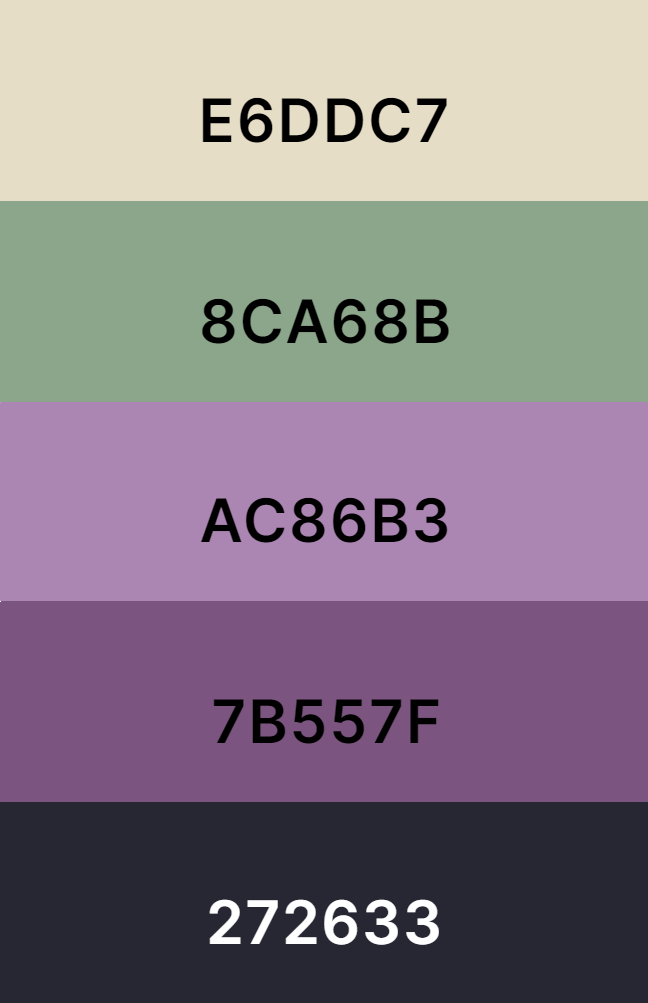
To structure the project to gain the best result, I used the design thinking process to make sure my project could be tested and further improved (S, 2020). I have edited the process slightly to make reading the project smoother, however all steps were taken when needed.
This process begins with defining the brief, however first I had to create the brief which I did in a meeting with the board game society committee to define what kind of game they would want made. I asked about their objectives as a society, the attitude in their society, and any message they had for the society. They told me that they liked to have a friendly and light-hearted attitude that prevented bullying among the members (which can unfortunately be common among board game communities). They also said their objective is to continue to accumulate members and encourage them to join the activities of the society. When I asked if they had any initial game ideas they wanted me to try out, or any prerequisites based on their experience with games that were already played, they said a game that worked well with smaller player numbers was ideal.
I also asked about what games were popular in the society, to which they said that games in the ‘Betrayal’ series were largely popular, along with ‘Codenames’, ‘Muffin Time’, and ‘Exploding Kittens’. One thing these games have in common is a high level of player interaction, to which they pointed out. Later, we drafted up this brief for the project.
The important notes to take from the brief was to make a game that had a high level of player interaction, without that ruining the experience for other players in the game. Due to the fact that board games are inherently competitive, as there is only one winner (in most cases), this means that when games have a high amount of player interactions, it usually involves bringing down other players in the game. This why ‘bullying’, as they put it, or sour feelings can fester after the game is over. To keep a positive atmosphere in the game, whilst keeping players feeling like they are influencing each other’s actions, would involve having minimal negative interaction, and diminishing a large competitive element, creating a team/cooperative based game, or encouraging people to use more positive actions towards each other over negative ones, rather than removing the option entirely.
To create a game with a high amount of player interaction, I thought it best I should define my own genres of player interaction. I identified them to be ‘bluffing’ which encompasses lying to people about what you may have to encourage them to make alternate plays. ‘betrayal/sabotage’ which might involve you making a move directly to bring one of your rival players down. ‘scheming/planning/teamwork’ which encompassed games such as the ‘Betrayal’ series where you need to work together to create a plan, or in betrayal’s case, a plan against another team/player. Similarly, ‘discussion/debate’ is also a more communication reliant method of player interaction, however was more about teamwork, or games where you may need to work together to get rid of a hidden villain, such as ‘Werewolf’. Finally, there was ‘trade/agreement/faction’ which was the more positive actions you could have when interacting with players, such as to make alliances with other players, though this does usually result in those alliances being used to take down others. I identified these types by breaking down elements of player interaction within games with high levels of player interaction.
I then proceeded to come up with four game ideas to present to the client. The first two were heavily based and inspired by the brief I was given, whereas the other two were more inspired by some other game ideas I had in order to give the committee a variety of ideas to choose from.
The first game was inspired by a game called 'Tsuro' which is commonly played at the society. It's a tile placement game where you gain points for extending your river with tiles. You have the option to merge rivers with other players to gain extra points, however this means that both you and your competitor are gaining points. This idea relies on the player interaction of 'faction' by merging your rivers together. The attempt is to make a positive player interaction of merging rivers without sabotage. The worst thing you can do to someone is merge rivers with them, where you both gain points, or deviate rives with them, where you both lose points, though not by a game changing amount.
The second game was a classic social deduction, but with a twist that, you knew who was on the other team (unlike most social deduction games) but you were instead socially deducting what actions you were taking. This game would likely fit under the ‘scheming’ section as well as ‘discussion/debate’ and may involve a bit of ‘bluffing’.
The third game was a little more unique and was about playing as doctors during the plague and seeing who could treat the most patients who all had very unique and funny symptoms.
The last game I presented was an aspirational asymmetric deck builder that featured people playing as witches preparing for a duel against one another by buying spells, familiars, and upgrades.

When presented to the committee, they said they liked both ‘Racing Rivers’ and the ‘Witchy Game’, but thought the latter was a little too big of an idea. I took their advice and decided to narrow the scope of the project a lot. Here, I outline the general idea of the game after receiving feedback from the committee.
I describe the game as an ‘asymmetric deck builder’ which has two parts to it. The ‘asymmetric’ part refers to a game in which players have different experiences of the game. In my game, players each start out with a different magic type which changes what they have at the start of the game. ‘deck builder’ refers to a genre of game where players cycle through their own deck of cards they have collected through the course of the game. For example, when they play a card from their hand, it goes into a personal discard pile which can then be used again when they cycle back to it. In my game, the cards you have in your hand act as ‘spells’ you are casting which cause actions in the game. These can be used to take more actions in your turn, or steal cards from other players. These spell cards are divided into five different magic types which dictate the type of action you are taking. To decide these action types, I looked at a variety of games with actions similar to the ones I wanted in my game, and divided them into different sections.
The first magic type is ‘Nature’ magic. These cards allow you to draw more cards from your deck, and offer more options to gain magic to buy more spell cards. The second magic type is ‘Healing’ which focuses on card movement and swapping hands. ‘Necrotic’ magic has cards that interact with discarding and discard piles. There is also ‘Temporal’ magic that focuses on taking more actions within a turn and ‘borrowing’ cards from other players. Finally there is ‘Oracle’ magic that allows you to look through decks and change the order.
Each card also has an alternate ability within the ‘duel phase’; a final turn at the end of the game which is an all-out battle in which players use their cards with a dwindling deck. Once their hand is empty, they are out of the game. The actions on the cards had some player interaction, like looking at other player’s hands, or borrowing cards from them, but were mostly passive. This resulted in what appeared to be not much player interaction, so I also added a karma system. By taking good actions towards other people, players would gain benefits in the duel, whereas powerful actions that would hurt another player diminished your chances in the duel. Good actions would reward 'favour' whereas bad actions gave 'corruption'.
Now that I had a solid idea of the general workings of the game, I wanted a better idea of the actions that would take place when playing it. Such things as what options did players have on their turn? How much could someone do on their turn? When did the duel start that ended the game? To answer these questions, I decided to look at games also in the deck builder genre to find out how they were structured.
The first game I looked at was ‘Adventure Mart’. In terms of structure, players had one action in a turn to do one of three things. Buy something, do something, or serve a customer. The round ended when there were no customers left to serve, and the game ended after five rounds, and you only ever draw from your deck at the beginning of a round. This is a very structured and numerical approach. There are always five rounds, there is always the same amount of customers to serve, and you only get one action, unless you play a card that allows more.
The second game I looked at was ‘Fort’ which was made by a company that specialises in asymmetric games, so I had high hopes. In fort there are not rounds, only turns.
You draw from your deck at the end of your turn which then moves to the next players turn. In Fort, you have a list of actions you have to take that keep the structure of the game consistent. You always have to play a card from your hand, you always have to take a new card from the deck. These consistent actions give everyone a fair playing field, but little choice. The game ends in one of three ways, one of which is accumulating enough points, the second is levelling up your ‘Fort’ to max level, and the third is the deck running out.
The last game I looked at was ‘The Tea Dragon Society Card Game’ which is a game based on a graphic novel. This game is structured into four rounds entitled ‘seasons’. The season ends when you take the last season card, which starts a new season, and the game ends after four seasons. On a turn you can either buy a card, or draw from your deck, in which you just keep drawing. This is a midpoint between having no rounds and drawing in your turn, and only drawing at the beginning of a round. However, the seasons only seem to act as a way to time the game and a way to shuffle the market of cards to buy from.
Inspired by my research, I decided to structure the game as follows: There are two actions you take on your turn. The first is to reveal some items in the shop, and the second is to choose between some actions. The first is to play a card from your hand, the second to buy a card from the shop, the third is to trade with another player, and the fourth action is to skip. By skipping, you do nothing, but once all but one player has chosen to skip, the round ends. The duel begins after five rounds. I then created card actions by looking at actions within other games and sorting them into one of my five magic types, and then adjusting them to fit the rules of my game. I also had to make actions during the duel phase. Truthfully, I didn’t know how the duel phase would work. Though I had the concept clear in my head, players playing cards from a finite hand to remove cards from each other’s hand in an attempt to empty their hand before your own, I’ve never seen the actions associated in another game. As such, I was unable to know how it would turn out when playing it. For this reason, I picked one action for each suit to do in the duel phase as a beta test. Another feature of the duel was the ‘counter-spell’ feature, where each magic type beat another in a rock-paper-scissors adjacent way.
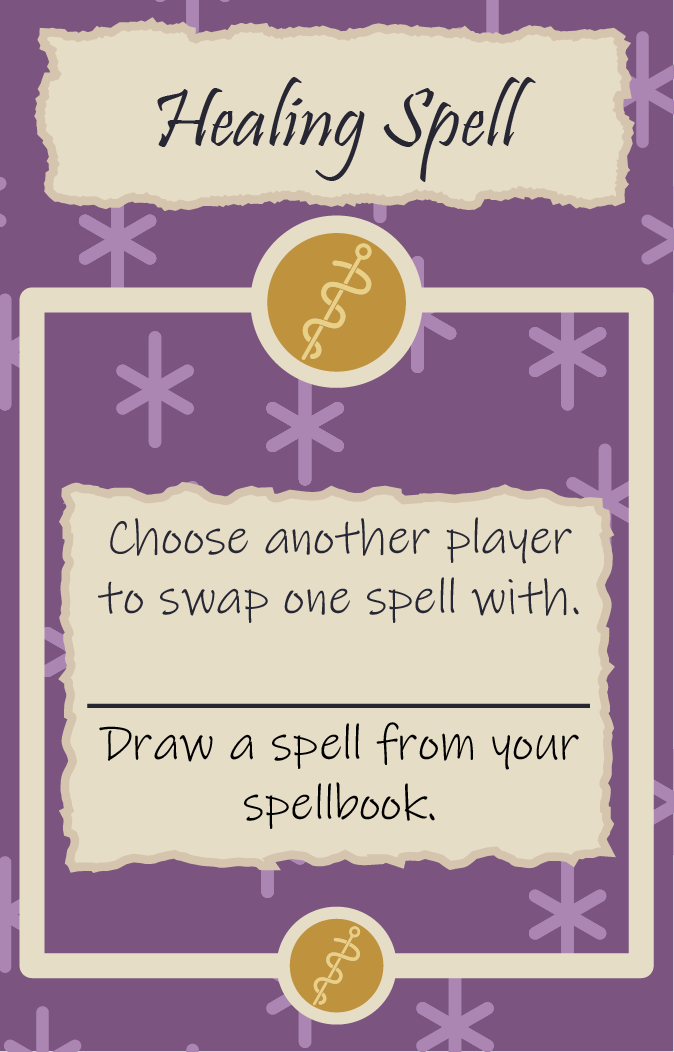
Click here to view all cards
Although I decided to delay doing appearance design work until next semester, I wanted to have icons to represent each magic type. For nature, I created some leafy and flowery designs. Healing was a little trickier. This wasn’t ‘health’, like in video games, this was more abstract. My first design was inspired by the goblet that grants eternal life, and a DNA strand to represent the science vs magic parts of healing. Whilst I like the representation, it doesn’t really match the style of witches. The second design was based on the Rod of Asclepius, owned by the Greek God associated with healing. Though this is a vague reference, it also looks similar to The Caduceus which is used in American healthcare as a common symbol (in fact, they mistook it for the Rod of Asclepius when making the logo). The Rod od Asclepius is also situated on the Star of Life, which is used on medical services. Overall, it is identifiable, and has roots in a symbol for healing. For Necrotic magic I had bones and a skull, then decided to add flames to the skull as is with many icons for necromancy in games. Temporal magic was also tricky. I had a couple of clock-based designs, but they didn’t feel very witch-like. I also had a hourglass which appeared to work a little better. The last one for Oracle, I had a crystal ball. This worked perfectly for scale as I was using a circle as a containment box.
When I showed the committee, they chose the leaf, the more developed staff, the flaming skull, and the hourglass. In reflection I probably should have also added some tarot cards as an option for the Oracle magic, however the client was particularly happy with that one.
I have had quite a few issues in the past using Illustrator to make icons, however when I used this tutorial to make the leaf icon, I finally understood how to use the pen tool, which helped me create all the others (Coyle, 2012).
This was my first test of the game, and my main goal was to understand how well the idea worked, as I had no idea if it even functioned up until this point. Though most of the game was based on research that should work, this was only in theory.
The main issue for the game was length. Even though there were only three people playing, each round lasted way too long, and one player wouldn’t be playing a majority of the time. People also said that quickly the shop became irrelevant, even forgetting to turn over the cards. This was somewhat due to the card abilities not being great, and also just having the cards from the shop flip in the round just seemed arbitrary, and forgotten once the cards were all flipped.
There were a couple more balancing changes needed, but mainly the healing cards were way too powerful. It was very easy to use all your good cards then swap hands with someone. One good thing about this was the cards to do this were so cheap, everyone would take this action, however it meant that hands were moving round the table more than I had anticipated for.
The duel worked well in practice, however I had added the option people could skip their turns instead of playing. When adding this, I had imagined it would be an equal sacrifice of not making an action to not play any cards. Instead, everyone decided to skip on their turns.
In this prototype, not only did I further develop to abilities in the duel phase, but I also addressed many of the large issues identified within the first test of the game. The first issue was the long turns and skipping, so I completely scrapped the idea of skipping on your turn, both in and out of the duel. Instead, the round would end when the shop was empty, similar to how in other deck builders the round would end when a certain deck queue was empty. I quickly realised, however, that due people not being able to draw more cards, there was a high chance that some of the shop cards may be unable to be bought in a turn, so instead I added an alternate round end if people were out of playable moves. I also changed the turns so players would have one action, including flipping cards in the shop, which would mean it was important choice.
Other than updating more action types in the duel phase, I also removed the skipping mechanic. After the first test, I realised that by removing the ability to stall, the duel would become a quick round at the end and simulate the anxiousness of a real fight, and scrambling for what to do. This would reflect a game of ‘Exploding Kittens’ where, at the end, all players are using all the cards in their hand in order to not draw the bomb in the deck.
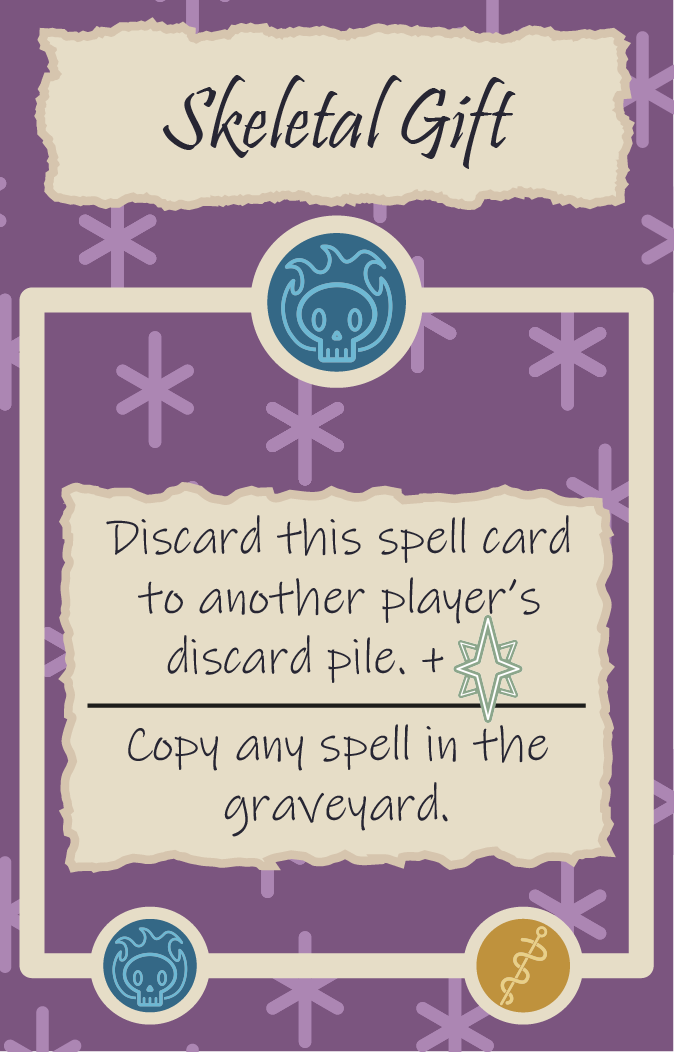
Click here to view all cards
This play-test was interesting, as I was able to observe how players who were unfamiliar with board games interacted with the game, especially without my influence. Other than teaching them the game, I offered them no insight on what they should do. This method of user testing was similar to Card Sorting (Sherwin, 2018) as I was letting users interact with the game without my influence, and letting them play the game and sort it as they would. Despite them having little knowledge on board game terminology, they were able to adapt and pick up the game quickly. As they had little experience with board games, they were also able to exploit some issues that may have been otherwise overlooked when playing with people familiar with the concept.
The main issue identified with this play test was the continued issue regarding round length. Though my solution should have worked, technically, at no point could you do “nothing”. Players are able to trade as long as both parties agree. This would not have been as big of an issue, had it not been for players gaining ‘favour’ whenever they traded. Favour is used to encourage positive actions, like trading, and gives you more cards in the duel phase. By trading back and forth, not only did rounds last way too long, but players were essentially printing points.
The main issue I needed to change for this iteration was limiting the amount of times people could trade. By creating a finite number of trades, not only did this put a cap on turns, but also would discourage people from taking unimportant trades by only having a few they could use in a turn.
In the prototype, I used three trade tokens, but when creating the game, I plan it to go on a counter on individual player boards.
This was my first play test with the client, and the first time they had seen how the game would be played. So far, they had only seen my progress, voted on decisions, and offered feedback, but this was the time they would see what the project had become.
Overall, the play test went well, and they really enjoyed the game, however had some suggestions. The first was adding a favour reward for having magic tokens at the end, as currently they were rather pointless after turns had ended. The second was they didn’t like being forced to play cards that they couldn’t use, so would like that amended, and the third was an issue with the balance of the game. Based on which magic type you started as, this would dictate the main magic type you gained from playing cards. Since players all started as a different magic type, if there were less than five people playing, less of that magic would be in the game. There was also still clearly an issue regarding round length, but it wasn't nearly as apparent as before.
I took the advice of the client and gave favour to whichever player had the most of each magic type at the end of the five rounds, and doubled the reward if it wasn’t the magic type they started with. I then, unfortunately, had to reinsert the skip action, as this seemed like the only option based on what the clients suggested. Unlike before, you can only skip if forced in a position to. This would be if none of your cards were playable, removing the issue in the test where players were feeling like they had to play cards that would currently do nothing. Based on the suggestion of the client, I also altered it so that unused cards based on player numbers would be shuffled amongst players in order to increase the amount of unused magic types.
Unfortunately, round length issues have persisted, and worse, the two alternate ways to end a round have become confusing. The idea of having ‘no more actions’ can be unclear when people are keeping cards, and sometimes you can trade, but you don’t want to, is this still being able to do nothing? The concept of being rewarded for having magic tokens at the end did really help, however. This made it so trades were much more considered and calculated as players were trying to figure out that, if by trading, they may lose their lead on a specific magic type. When trying shuffling excess cards between players, it did improve the flow of other magic types in the game, however also had the effect of oversaturating the duel phase with useless cards so I had to create some alternate rules on the spot to fix the issue.
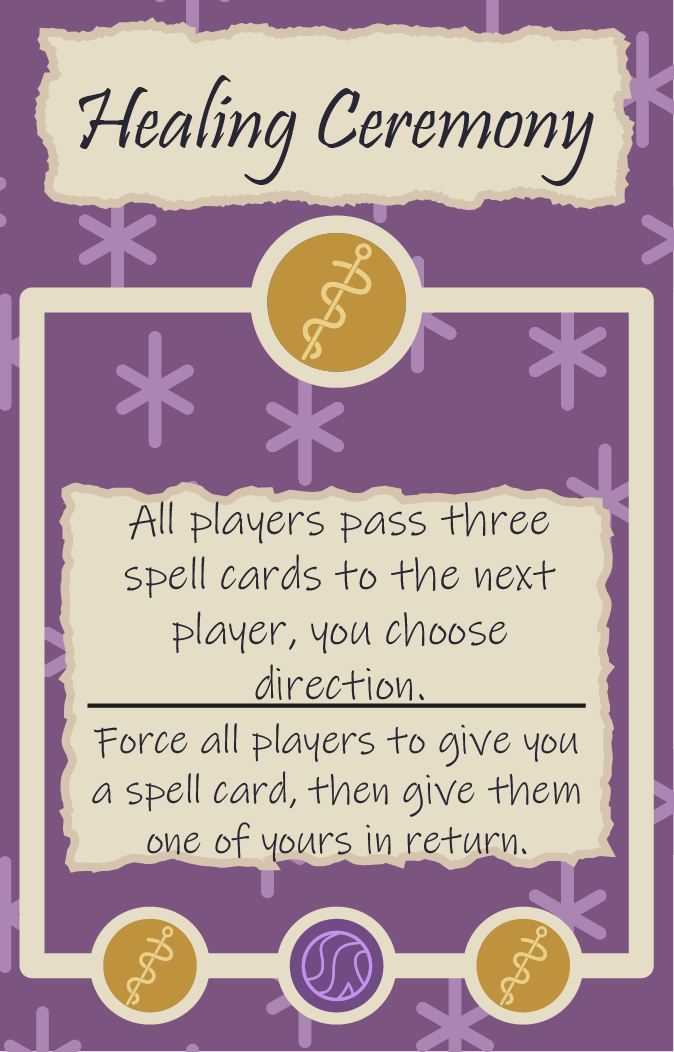
Click here to view all cards
This prototype involved alternating a few of the cards I had noticed needed balancing changes, and a couple of cards that had been commonly complained about.
I still had my issue about round lengths and not enough magic of unused types. By looking back on my game research, others fixed this issue by having a card queue you had to work through wherein the round would end immediately. I had thought I’d had this with the shop queue, however, had noticed early that often the shop couldn’t be afforded. I then realised, if I could create a finite way for players to gain extra magic tokens per round, this would fix both issues I had, as when this action ran out, the round would end. I then edited the counter-spell chart and added some spaces for tokens, then I altered the rules so that the round would only end when all spots were filled. By filling a space, you gained two of that magic type. This also fixed my issue of players not wanting to play cards, as they could always passively gain magic tokens.
I am yet to play test these new rules, however I am confident in their ability and will be play testing them soon.
Though I have done little work regarding branding this semester due to wanting to focus on gameplay, I did create a colour scheme to add atmosphere to the game.
I chose purple as a main colour as it is largely synonymous with witchcraft, magic, and mystery. The green is a contrasting colour to the purple in order to stand out, this is my call-to-action colour. I then also have a light shade to the colour scheme and a darker colour. I think they work really nicely together. The cream works well as parchment to write text on, and the darker colour is mostly used for text and makes for a nice cauldron colour.
I chose the name ‘Coven Chaos’, however this was only supposed to be used as a placeholder. By now, the name has grown on my, but in semester two I will do proper research into a name. I would have liked to have solidly chosen one by now, but didn’t have time as I was so focused on gameplay.
